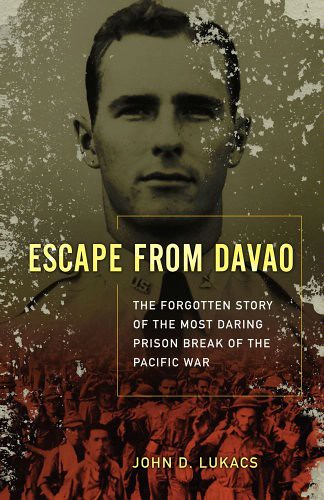At the heart of "Escape from Davao" is a great story – the daring escape of 10 American prisoners of war from Japanese captivity in the Philippines during World War II. The escape itself, dramatic and suspenseful, falls in the middle of the book and is the highlight of the work. The other parts of the book, which look at the fighting that led up to the capture of the Americans and the events after their escape, have some interesting parts but are not as gripping as the middle section.
I didn't know much about World War II events in the Philippines before I picked up "Escape from Davao," so the first section showing the desperate fighting by outmanned American troops trying to defend the islands in 1942 was enlightening. Author John D. Lukacs describes how the U.S. government basically abandoned the American forces there, forcing the surrender that led to the brutalities of the Bataan death march. Lukacs further details the starvation and abuses of Japanese prisoner of war camps (for more on this, read Laura Hillenbrand's compelling bestseller "Unbroken").
Lukacs writes competently, but even given good material to work with, his storytelling is fairly flat and he sometimes bogs down the book with excessive minutiae. He tells the story entirely from the point of view of the American soldiers, giving it a simple good-guys-versus-bad-guys storyline. This is not terrible (the Japanese captors really could be awful), but more from the perspective of the Japanese or from the Filipinos who helped the Americans would have given the book greater depth.
In the middle section, as the Americans plot and then execute their escape plan, the action proves page-turning, but it's sometimes hard to tell the characters apart. Lukacs profiles the Americans so similarly -- tough, gung-ho young men all willing to chip in to help the team -- that it is difficult to distinguish one from another.
The last part of the book shows how the escaped prisoners' tales of Japanese brutality struggled to be told publicly in the face of extreme military censorship and message control. Lukacs wanders quite a bit in this section before finally coming to a remarkable point: It took nearly two years for the horrors of the Bataan death march and Japanese POW camps to be revealed to the American people. In this day of instant news updates and Twitter bulletins, it's amazing to realize how different things were back then.
One minor annoyance is that Lukacs uses military time ("1700 hours" and so forth) throughout the book, making me wonder if he expected only members of the armed services to read the book.
The book has some nice maps, but they are introduced too early and give away some of the story. Similarly, the book has a batch of photos at the middle of the book and if you look at them too soon, they reveal what happens to the characters.

No comments:
Post a Comment